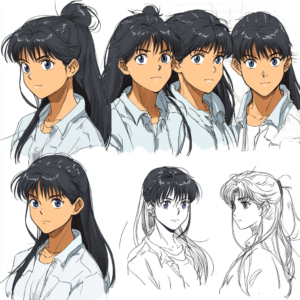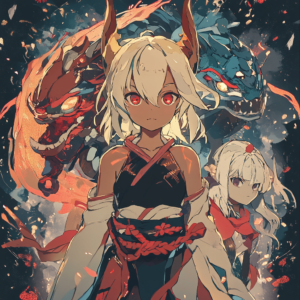1. Introduction
Animation has the power to transport us into new worlds, evoke deep emotions, and introduce us to unforgettable characters. In this comprehensive guide, Anime Character Development: Lessons from the Best provides an exclusive look into how characters in anime evolve into complex, relatable figures. Our focus keyword, Anime Character Development, serves as the guiding light of our exploration. In the pages that follow, we delve deep into techniques, historical evolution, and creative processes that underpin memorable character arcs. Whether you are an avid fan, a casual viewer, or an aspiring creator, this guide will enrich your understanding of storytelling and character evolution. We also explore the human side of the creative process—the passion, perseverance, and collaboration that bring these narratives to life. For further insights into narrative intricacies, visit Breaking Down the Latest Anime Movie Plot Twists and join discussions on Exploring Anime Fandom: Trends, Theories and More.

2. The Importance of Character Evolution in Anime
Effective character growth is the backbone of engaging storytelling. When audiences witness a character’s journey from uncertainty to self-realization, the narrative becomes profoundly immersive and emotionally rich. Thoughtful evolution transforms static figures into dynamic, relatable individuals whose struggles and triumphs mirror real life. This process, central to Anime Character Development, not only deepens viewer engagement but also builds lasting connections between the audience and the story. Through interviews and behind-the-scenes insights, creators reveal that every subtle change—whether in dialogue, expression, or visual design—is carefully crafted to enhance a character’s authenticity. Experts on Anime News Network illustrate how series that prioritize robust character arcs tend to resonate more deeply and achieve enduring success. Ultimately, strong character evolution is not just a narrative technique; it is the emotional heartbeat that makes the story come alive.
3. Historical Evolution of Anime Character Development
Early Portrayals
In the early days of animation, characters were often designed as archetypes. Simple and direct, these figures served to communicate clear moral lessons or support action-driven plots. Although lacking in nuance, these early portrayals laid the foundation for the rich storytelling traditions that would follow.
The Shift Toward Complexity
As the medium evolved, anime began to introduce characters with more intricate backstories and internal conflicts. Writers started exploring themes of loss, ambition, and redemption, gradually moving away from one-dimensional portrayals. This evolution marked a turning point, where character arcs became a central pillar of narrative structure. Viewers began to appreciate characters not just for their roles in the story but for their personal journeys and growth over time.
Technological Advancements
Technological innovations have also played a significant role in this transformation. The shift from traditional cel animation to digital techniques allowed for more detailed and expressive portrayals. Enhanced animation techniques enabled creators to capture subtle facial expressions, fluid motion, and nuanced body language, all of which add layers to character evolution. This progress has paved the way for modern narratives that are rich in detail and emotional resonance, shaping the way audiences connect with animated figures.
4. Core Techniques and Strategies in Character Development
Narrative Tools and Backstories
One of the fundamental approaches to compelling character evolution is the integration of detailed backstories. Creators employ flashbacks, inner monologues, and symbolic storytelling to reveal a character’s history and inner motivations. These narrative tools help explain current behaviors and set the stage for future growth.
Gradual Transformation
Effective evolution occurs gradually. Incremental changes in personality, appearance, and behavior allow the audience to witness a natural progression. This method of evolution creates continuity and believability, ensuring that every development feels earned.
Visual and Dialogue Cues
Subtle visual cues—such as changes in attire, evolving hairstyles, or shifts in color palette—work in tandem with thoughtful dialogue to signal transformation. These elements reinforce the internal changes and contribute to a cohesive, immersive narrative experience.
Consistency and Cohesion
Maintaining a consistent narrative is essential. Each development should logically follow from previous events, ensuring that the character’s journey is both relatable and engaging. By adhering to these principles, creators build robust character arcs that resonate with viewers over time.
5. Case Studies: Iconic Characters and Their Journeys
Naruto Uzumaki in Naruto
Naruto’s evolution from a mischievous, ostracized orphan to a determined, empathetic leader is a classic example of enduring growth. His journey is defined by perseverance, friendship, and the gradual revelation of his inner strength, making his transformation a touchstone for emotional storytelling.
Monkey D. Luffy in One Piece
Luffy’s evolution in One Piece is characterized by his transformation from a carefree adventurer into a responsible captain who values loyalty and honor. His growth is marked by trials that test his resolve and showcase his unwavering spirit, setting a benchmark for dynamic character progression.
Eren Yeager in Attack on Titan
Eren Yeager’s arc is noted for its complexity and moral ambiguity. His journey from a passionate, impulsive youth to a conflicted and determined figure challenges viewers to confront difficult questions about heroism and sacrifice. These examples illustrate how layered character arcs can elevate a narrative, making the evolution both compelling and relatable.

6. Lessons from the Masters: What We Can Learn
Studying the journeys of well-crafted characters reveals valuable lessons for both creators and fans. Consistency is critical—characters must evolve in a way that feels natural and rooted in their established backstories. Vulnerability is another essential quality; when characters expose their weaknesses, they become more relatable and engaging. Additionally, the blend of humor and drama can add depth, creating a balanced narrative that mirrors the complexities of real life. These principles provide a blueprint for creating memorable arcs that leave lasting impressions on audiences.
7. The Role of Narrative and Visual Storytelling
Integrating Story and Visuals
A character’s evolution is not only told through dialogue but is also powerfully conveyed through visual storytelling. Directors use color shifts, lighting variations, and strategic framing to reflect internal changes. For example, a gradual shift in a character’s wardrobe or facial expressions may symbolize their emotional growth over time.
Enhancing Emotional Depth
The effective combination of narrative and visual elements results in a richer, more immersive experience. Every detail—from a quiet moment of introspection to a dramatic transformation scene—contributes to the overall journey, making the evolution feel both impactful and personal.
8. Insights from Industry Experts and Creator Interviews
Interviews with anime creators provide firsthand insights into the creative process. During these sessions, directors, writers, and animators reveal the challenges they face and the strategies they employ to refine character arcs. They emphasize the importance of iterative feedback and collaboration, noting that every revision—from voice acting adjustments to storyboard modifications—plays a vital role in achieving a coherent narrative. These candid discussions not only offer practical advice but also inspire a deeper appreciation for the artistry involved. Learning from these experts underscores the complexity behind each character’s journey and demonstrates that successful evolution is a collaborative, ever-changing process.
9. The Impact of Cultural and Global Influences
Cultural heritage plays an integral role in shaping character development. Traditional Japanese values such as honor, perseverance, and community are often interwoven with modern narrative elements, creating characters who are both timeless and timely. Moreover, as anime reaches a global audience, cross-cultural influences emerge, enriching character arcs with diverse perspectives. This fusion results in narratives that resonate on multiple levels, ensuring that the characters not only reflect their cultural roots but also speak to universal human experiences. Such a blend of influences deepens the emotional impact and broadens the appeal of animated storytelling.
10. Overcoming Challenges in Long-Running Series
Maintaining Continuity and Consistency
In long-running anime series, one of the greatest challenges is ensuring continuity and consistency in character evolution. As storylines expand over many episodes or seasons, maintaining a coherent narrative becomes increasingly complex. Creators must carefully plan character arcs from the outset and continuously revisit earlier plot points to ensure that new developments align with the established history. This requires detailed documentation, storyboard reviews, and sometimes even revisions of past episodes. By establishing clear guidelines and milestones for character growth, teams can preserve narrative integrity while allowing characters to evolve naturally over time.
Adapting to Changing Creative Teams
Another significant challenge arises from shifts in the creative team over the lifespan of a series. As new directors, writers, or animators join the project, their individual styles and interpretations can lead to discrepancies in character portrayal. To overcome this, many studios implement rigorous briefing sessions and maintain comprehensive production bibles that detail each character’s history, personality traits, and growth trajectory. This collaborative approach helps new members align with the original vision, ensuring that even as personnel change, the core essence of character development remains consistent.
Balancing Innovation with Established Narratives
Long-running series must also balance the need for innovation with the established narrative. Introducing fresh ideas and plot twists is essential to keep the story engaging, yet sudden or unexplained changes can disrupt the continuity that fans have come to expect. Successful teams strike this balance by gradually integrating new narrative elements and testing them through pilot episodes or internal reviews before full implementation. This iterative process allows for creative experimentation while still respecting the foundational elements of character evolution, ensuring that every innovation feels like a natural extension of the character’s journey.
Utilizing Feedback and Iterative Revisions
Feedback plays a crucial role in refining character arcs over time. In many cases, creators actively engage with fans through social media, conventions, and online forums to gauge audience reactions. This direct input can highlight areas where the narrative might be falling short or where characters are not resonating as intended. By incorporating this feedback into iterative revisions, studios can fine-tune character development, address inconsistencies, and make adjustments that enhance the overall story. This dynamic, responsive approach not only improves the quality of the series but also strengthens the bond between creators and their audience.
Collaborative Problem-Solving and Future-Proofing
Overcoming the challenges of long-running series is ultimately a collaborative effort. Regular team meetings, cross-departmental workshops, and brainstorming sessions help ensure that every member of the production team is aligned with the vision of character evolution. In addition, investing in future-proofing strategies—such as establishing long-term narrative roadmaps and using digital tools for detailed continuity tracking—can safeguard against unforeseen changes. By fostering an environment of open communication and mutual respect, creators can navigate the inherent challenges of prolonged storytelling and ensure that character development remains a central, compelling aspect of the series.
Through these comprehensive strategies, the challenges of sustaining evolving character arcs in long-running anime are met with resilience and innovation. The commitment to preserving consistency while embracing new ideas is what ultimately defines successful character evolution, ensuring that each narrative remains engaging, coherent, and deeply impactful.
11. Future Trends in Character Development
The future of animated storytelling is set to be revolutionized by emerging technologies and new narrative approaches. Interactive platforms, such as augmented reality (AR) and virtual reality (VR), are poised to create immersive experiences that allow audiences to engage directly with character journeys. Advances in artificial intelligence (AI) promise to streamline production and enable even more nuanced expressions and dynamic storytelling. Global collaborations are expected to intensify, introducing fresh perspectives that will further enrich narrative complexity. As the industry evolves, the way characters are developed will continue to adapt, creating richer, more inclusive stories for audiences around the world.
12. Frequently Asked Questions
Q1: What is Anime Character Development?
It refers to the process by which characters evolve through detailed backstories, emotional growth, and dynamic narrative arcs that drive the story forward.
Q2: Why is consistency in character evolution important?
It ensures that a character’s growth feels authentic and relatable, strengthening the audience’s connection with the narrative.
Q3: How do creators blend traditional art with modern technology?
They combine hand-drawn techniques with digital tools such as CGI and digital compositing to enhance visual detail while preserving expressive qualities.
Q4: What role do cultural influences play in shaping character arcs?
They infuse the narrative with traditional values and contemporary issues, making characters more multidimensional and globally resonant.
Q5: What advice is offered to aspiring animators?
Veteran creators emphasize perseverance, continuous learning, and maintaining a unique creative voice while balancing traditional methods with modern innovations.
13. Call to Action & Affiliate Offers
If you’re interested in diving deeper into other topics, I recommend checking out this comprehensive guide that walks you through each step with video tutorials, downloadable resources, and expert insights. Check it here. Your support is essential in helping us continue delivering high-quality content that informs, inspires, and empowers you to master the art of character evolution.
14. Creator Interview Case Study
As a special highlight, we present a detailed case study drawn from an in-depth Interview with Anime Creators session focused on character evolution. In this case study, a renowned anime director explains how meticulous planning, collaborative efforts, and the integration of digital technologies transformed the arc of a central character in his series. He describes the initial brainstorming sessions, the evolution of storyboards and sketches, and the vital role of voice acting in conveying subtle emotional shifts. The director also discusses overcoming challenges such as tight production deadlines and balancing creative ambition with commercial demands. This case study exemplifies effective character evolution and offers actionable insights for aspiring creators. To gain a visual overview of this process, watch this YouTube video on behind-the-scenes anime character development.

15. Conclusion
Anime Character Development: Lessons from the Best offers an in-depth exploration into the intricate process of evolving animated characters that define memorable series. Through historical context, detailed case studies, expert interviews, and comprehensive analyses of narrative and visual techniques, this guide has illuminated how thoughtful evolution enriches storytelling and builds enduring connections with audiences. Every creative decision—from subtle dialogue nuances to dramatic visual transformations—plays a crucial role in building characters that resonate long after the final scene. As you continue to enjoy your favorite series, take a moment to appreciate the artistry behind each character’s journey. Let this guide inspire you to further explore the creative process and foster a deeper appreciation for the art of animated storytelling.
